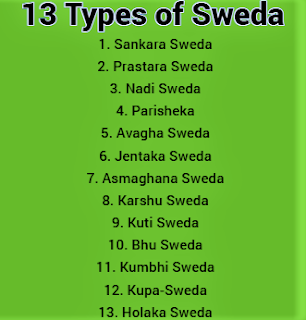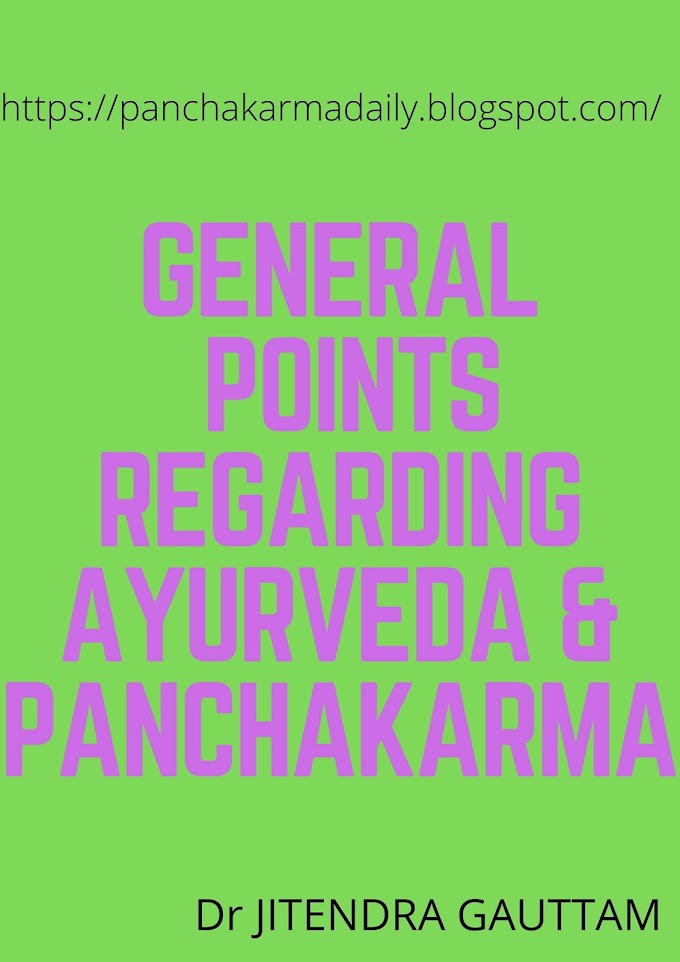When there is involvement of fire as heat source it comes under Sagni Sweda or Agneya Sweda. There are 13 types of Sagni Sweda.
सङ्करः प्रस्तरो नाडी परिषेकोऽवगाहनम्|
जेन्ताकोऽश्मघनः कर्षूः कुटी भूः कुम्भिकैव च||
कूपो होलाक इत्येते स्वेदयन्ति त्रयोदश| (च.सू-१४/३९)
- Sankara Sweda
- Prastara Sweda
- Nadi Sweda
- Parisheka
- Avagha Sweda
- Jentaka Sweda
- Asmaghana Sweda
- Karshu Sweda
- Kuti Sweda
- Bhu-Sweda
- Kumbhi Sweda
- Kupa-Sweda
- Holaka Sweda
The
method in which the materials are tied in a cloth and used in Swedana is
known as Sankar Swedana. It is commonly known as Pinda Sweda.
This method is mostly is used and may be differentiated thousands times as the
material differ from one to another.
Some mostly used Sweda are:
- Shastikashali Pinda Sweda
- Patra pinda sweda
- Jambeera Pinda Sweda
- Churna Pinda Sweda
- Valuka Sweda
- Anda Sweda
All Sankara Sweda are primarily divided into two types:
- Snigdha Sankara Sweda
- Ruksha Sankara Sweda
The
division has been made considering the Dosha involvement of diseases.
Vata
disease- Snigdha Sweda.
Kapha
dominating disease, Meda Roga, Amavastha- Rukhsa Sweda.
PRASTRA
SWEDA
Preparing
the Swedana material and spreading the same over a standard sized stones
slab or floor and covering it with a cloth or blanket or Vatahar leaves,
the patient is asked do lie down over it and Swedana is to be done.
Normally,
the patient is to be advised to lie on droni or the straw over floor which is covered
with clothes. Swedana Dravyas should be spread over it.
NADI
SWEDA
Swedana
by the steam of medicinal herbs by a special type of instrument known as Nadi
Yantra called Nadi Swedana.
AVAGAHA
SWEDA
Immersion
of body parts by warm medicated Kwatha or Taila, Ghrita, Sneha
etc kept in a large tub is called Avagha Sweda.
Avagaha
means ‘MAJJANA’ that denotes to ‘IMMERSION’, ‘SINKING’, DIPPING’ etc.
PARISEKA
Lukewarm
decoction of several medicines when showered over body is called Pariseka.
In
this procedure also, the medicines are to be collected according to the
involvement of the Dosha. It is mainly used in Vata or Vata-
Sheleshma condition. It should be applied to the patient who is properly
oleated and covered by a cloth. It can be applied as per Kayaseka or Sarvanga
Seka as mentioned in Snehadhyaya.
JENTAKA
SWEDA
This
is a type of Agni Sweda which was popular in ancient India but nowadays its
use is almost gone. In this procedure, highest form of Swedana can be
achieved. It is really impossible to perform in OPD level. It only can be done
in IPD level where a special Kuti is to prepare for this purpose.
Jentaka
Kuti
The
detailed description of this Kuti is given in Charaka Samhita. Special type
of Kuti should be prepared in a place having black or golden colored
level land that is Madhura in nature in the north or east side of the
house of the patient (or of the village). A water reservoir or pond or river should
be present 12ft. apart in eastern or northern side of that Kuti. The Kuti
should be of 16 ft. in diameter and height and its door should be facing north
or east. It should have many windows in it and it should be properly cleansed.
A bench like structure of 1.5 ft width and 1.5 ft. height should be all around
the wall except the door area. A hollow pillar which is 6 ft. in diameter and
9.5 ft high is to be placed at the centre of the Kuti. It is to be
filled with the wood of Khadira or Ashvakarna and then brunt.
When all the woods are brunt and the Kuti becomes free from fume, the
person properly massaged with oil should enter this Kuti.
Method
At
first the patient should be prepared. First of all, a clear idea about jentaka sveda
is to be given to him. He should be strictly advised not to leave the room even
if he feels extremely uneasiness due to excessive heat of the Kuti. Then
the patient should be massaged properly with suitable oil and covered with a
cloth. Now he is allowed to enter into the Kuti. The patient may lie on
either side of his body over that bench and may change his posture as par his
choice during the procedure. When the patient himself will feel that he is
totally free from Kapha or his sweat has been discharged completely, his
channels are free from any obstacle, body becomes thin and light, there is no
stiffness, numbness, pain and heaviness anymore; only then he can come out from
the Kuti.
ASHMAGHANA
SWEDA
At
first a long piece of stone which is similar to the length and width of the patient
is to be collected. The wood having Vata alleviating property is to be burnt
over it. After complete burn, the charcoals are to be removed from the stone
and then it should be wiped out properly by the water. Then a blanket should be
kept over the stone and properly massaged patient is to be advised to lie down
over it. Then he should take Swedana by covering himself with other
blankets.
KARSHU
SWEDA
A
deep hole whose bottom portion is wide but the opening is narrow is called Karshu.
A cot having several holes is to be kept over it. Karshu is to be filled
with fumeless charcoals and then a properly massaged person is to be allowed to
lie down over the cot to take Swedana.
KUTIRA
SWEDA
A
round shaped, not too high not too wide Kuti, having no window is to be built
at first. Then the wall of this Kuti is to be anointed by the paste of Kushtha
or such type of drugs. A cot properly arranged as bed by the blanket, etc. is
then to be placed at the centre of the Kuti. Four vessels containing
fumeless charcoal are to be placed in the four corners of that cot. Then a
properly massaged patient is to be advised to lie down over that cot to take Swedana.
The
basic difference between Jentaka and Kutira Sweda is
intensity of temperature. In Jentaka, the temperature is more severe.
BHU
SWEDA:
It
is similar to Ashmaghana Sweda. The only difference 1S in bhu Sweda,
the land isinstead of stone".
A
big pitcher (of twenty litre capacity) should be taken and its 2/3rd portion or
1/2 is to be buried in earth. Decoction of Vata alleviating drug is to be
poured into it. Then a red hot iron ball or hot stone is to be kept in that
pitcher. A cot or chair having several holes in its seat is to be placed over
that. A properly massaged person is then allowed to sit or to lie down over it
covering himself with blanket or thick cloth to take Swedana by the
steam evolved from the pitcher.
A
hole in the soil is to be dug twice as high as the height of the patient, in a standard
case, the size of bed is 6 ft x 2 ft. So the size of the Kupa should be
6 ft x 2 ft x 12 ft. The inner wall of the Kupa is to be an anointed
properly. Then the stool of elephant, horse, cow, ass, etc. is to be poured in
it and then brunt. When the fume stops, the patient is allowed to lie down over
a bed placed over it".
HOLAKA
SWEDA:
At
first a container having the length and width of a standard bed should be poured
by the heap of dung (of elephant, horse, cow, ass or camel, etc. as stated in Kupa
Sweda) and brunt. When the smoke disappears, a bed should be prepared
over it and patient is to be advised to lie down over it to take Swedana.
13 types of Swedana- Sagni Sweda




1 Comments
Explained Explicitly 👌🏻
ReplyDelete